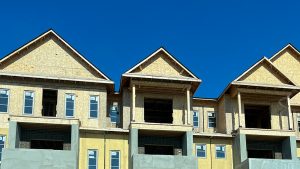A crisis is brewing in Alberta as massive homebuilding and renovation demand has caused supply costs to soar.
The issue has Building Industry Land Development Association Alberta (BILD Alberta) starting to sound the alarm.
“My phone and email started blowing up a week ago with some builder members raising concerns,” said Scott Fash, executive director of BILD Alberta. “Now we are reaching out to builders and supplier companies to better understand it and we are trying to dig in and figure out the problem as well as potential solutions.”
Fash said BILD members are reporting up to 75 per cent cost increases on oriented strand board and pine products. For a builder that is a $7,000 to $10,000 increase in material costs for a home.
“Suppliers called it a perfect storm,” said Fash, explaining that an unexpected boom in homebuilding and renovations hit just after some mills had shut down due to COVID-19.
“There is a really positive side to this. As we are trying to recover, having a strong construction sector is positive. The downside is that it has outpaced what mills anticipated. A $7,000 to $10,000 increase is nothing to sneeze at.”
Fash said some builders may attempt to eat that cost until prices go down, but the majority will have to go renegotiate with homebuyers and suppliers to spread the cost out because they cannot afford it.
“I don’t know where or how this levels off,” said Fash. “Maybe in winter the demand reduces or mills up capacity.”
Fash said BILD Alberta has been gathering data and reaching out to provincial officials for solutions but added that it isn’t just an Alberta issue. Everyone is beginning to experience strains on supply.
The group’s national body, the Canadian Home Builders’ Association (CHBA) has been trying to work with Ottawa on interim solutions.
“It is nobody’s fault,” said Fash. “It is a perfect storm, but what can we do to address this because I don’t think we can keep operating with a 75 per cent increase on these products. If we want to have a strong construction and renovation sector that fuels recovery it is important to figure out a solution if one is available.”
The Alberta Forest Products Association (AFPA), which represents the province’s forestry products industry, explained they are unsure if much can be done to produce more materials.
“On the producer side we have seen a really hot lumber market,” said Brock Mulligan, communications director for Alberta Forest Products. “We had a bit of production go offline when COVID-19 first hit, but otherwise things ran steadily. Now, of course, with demand and the market being so hot, everything is running at full capacity in Alberta.”
He explained the industry has seen volatility in the lumber market in the past few years. But in June this year it started to see unprecedented jumps in price. He said the prices aren’t sustainable and believes that over time they will even out.
“I think in Alberta the thing that drives production levels is the availability of wood to put through the mill,” said Fash. “We have invested in improvements to make mills efficient but ultimately you have a resource that takes 80 to 100 years to grow. There is only so much you can do to crank up production levels.”
Fash said thinking about the long-term sustainability of the forestry sector is important.
“The Alberta economy is in a vulnerable spot right now,” he said. “COVID hurt the entire economy but Alberta took a double whammy of poor oil prices and economic disruption. We have seen in the 70 communities where there are forestry operations that there is some insulation, stable jobs and I think there is great value in a healthy forest industry.”
Follow the author on Twitter @RussellReports.











Recent Comments
comments for this post are closed